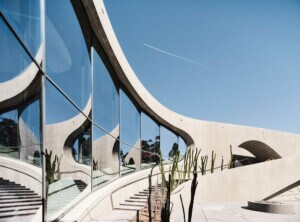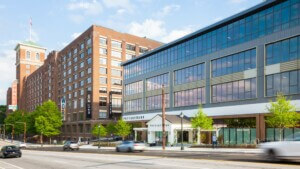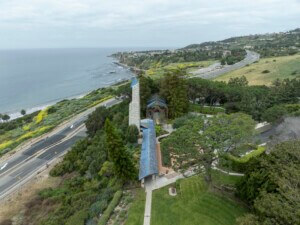“When I am in California, I am not in the West. I am west of the West,” declared Theodore Roosevelt at the turn of the 20th century. The potential for self-reliance implied by Roosevelt was felt at that time by countless western settlers, who together transformed California—particularly its southern half—into a sea of low-rise development and automobile infrastructure within a matter of decades. Yet an alternate reading of Roosevelt’s proclamation, which envisions limitless potential for new modes of living and working, became both the inspiration and namesake for West of West. A young Los Angeles–based architecture firm that responds to the western landscape of the 21st century, the studio offers fresh approaches to community building through novel design practice.
Cofounders Clayton Taylor and Jai Kumaran resist operating as a top-down design practice. Following their shared early-career experience at Morphosis Architects, they intentionally seek input from all ten people in their office throughout each step of the design process.
How do they maintain the levels of patience and humility necessary for creative equity? “Don’t be an asshole,” Kumaran told me. We were sitting in the West of West studio space, set within a sunbaked shopping center in L.A.’s Chinatown. “We hire people who know things we don’t know, people who notice details that go over our heads.”
This faith in others extends into many of the types of projects West of West has secured over the past eight years. Operating in a city known for single-family houses, the office has amassed a portfolio of multiunit housing projects that “sneak” density into low-rise neighborhoods. Design strategies like outdoor circulation paths and spacious communal facilities help projects succeed in unexpected places by inspiring human connection and collaboration. Even when working on building types often associated with social alienation, such as the ever-daunting office campus or bank tower, the studio similarly instills opportunities for interaction through well-placed community amenities amid warm materials.

Garrett Leight Los Angeles 2015
Before Garrett Leight became synonymous with upscale sunglass design, he and Kumaran were college friends with disparate passions. Taylor and Kumaran’s design sensibilities are visible on the smooth, undulating surfaces of their flagship for Garrett Leight California Optical, the first of many designs West of West would complete for the sunglass company. The interior was conceived as a habitable billboard: It’s large enough that motorists speeding down La Brea Avenue can peer into its expansive glass facade. The billowing wall along the shop’s interior is visually propped up by sinuous plywood built-in cabinetry to match the clean yet relaxed aesthetic of Garrett Leight’s sunglass line. The wall is additionally broken up by a field of plywood pegs that serve as supports for shelving that can be easily modified, depending on changing collections and product quantity. The design scheme was so successful that West of West was invited to translate the same sweeping language to the brand’s SoHo, Manhattan, location later that same year.

Eastbound 2022
In East Austin, West of West recently completed Eastbound, a 230,000-square-foot creative campus with a number of design details that distinguish it from the typically alienating office park. The campus consists of two large industrial buildings with precast square paneled facades punctuated by newly punched square windows. Inspired by the functionalist industrial buildings across the way from the three-acre site, the treatments retain their gritty character while new interventions bring copious natural light into expansive open floorplans. “The outdoor pathway that runs in between the two buildings is wide enough to host opportunities for socializing,” said Kumaran, “but also narrow enough to receive regular shade from the bordering facades to beat the hot inland Texas weather.” Along the pathway, the wraparound glass facade of the ground floor appears to be lifting up the concrete mass above with the assistance of dramatically tilted concrete columns.

6344 Fountain 2023
Though it is one of the first commercial office buildings in Los Angeles to combine cross-laminated timber (CLT) with steel framing, 6344 Fountain does not wear the trendy material on its sleeve. When commissioned to add a 50,000-square-foot addition to an existing two-story commercial building in Hollywood, California, West of West chose to draw inspiration from the unique culture of the neighborhood. The result is a pile of cubes with contrasting cladding materials scattered across the block in a manner reminiscent of early Frank Gehry. While the ground floor of the addition is visually broken up by thoughtful landscaping, the upper floors of the addition are composed of interweaving office and terrace spaces with views of the Hills to the north. “Everyone in Hollywood wants a view,” Kumaran joked as he explained how the luxuriant outdoor spaces entice technology and film companies to lease spaces.

Echo Park Co-Living 2022—
Steep slopes have been the mothers of residential invention in Los Angeles since single-family homes were first placed in the Hollywood Hills more than a century ago. When tasked with designing Echo Park Co-Living, West of West devised a “slow stair street” that gently weaves the units together along a common meandering path. Like Sunset Steps, a multiunit housing project currently in the works in San Francisco, Echo Park Co-Living resolves several issues with low-rise development with a single solution: “We wanted to reimagine how sites typically designated for single-family homes could both increase housing density while also benefiting the surrounding neighborhood through community amenities,” said Kumaran. While each stand-alone unit includes its own rooftop deck—an amenity that is far less common among homes across Southern California than it should be—each unit’s ground floor remains in dialogue across the site.
Shane Reiner-Roth is a lecturer at the University of Southern California.











